Diagrams of Theory: Parsons' and Merton's Typology of Deviance
In nearly every undergraduate sociology course, we discussed the mid-century sociological tradition “structural functionalism.” But, for me at least, discussions of Talcott Parsons, the theoretical powerhouse that spearheaded the rise of structural functionalism, was strangely absent from my undergraduate sociology courses. This may have been a result of the particular theoretical commitments of my professors, rather than characterizing American sociology broadly. When I finally encountered Parsons, it was primarily as a foil against which “good” theory is measured – although this may be changing. In any case, Parsons trained some of the foremost theorists, including Robert K. Merton.
Merton’s Typology of Deviance predates Parsons’ own. But, the latter considers Merton’s theory to be a “very important special case” of his own general theory of action. In Sociological Theory - A Contemporary View: How to Read, Criticize and Do Theory (which, I highly recommend. It is also appears to be the front half of Smelser and Warner 1976), Neil Smelser (also a student of Parsons) directly compares and critiques the two theories of deviance.

Merton hinges his typology on the notion of “anomie,” which he defines as the misalignment of cultural goals with institutional means. Although Merton theorizes within the tradition of structural functionalism, he recognizes that the operation of different social systems is not inherently beneficial to the functioning of society as a whole.
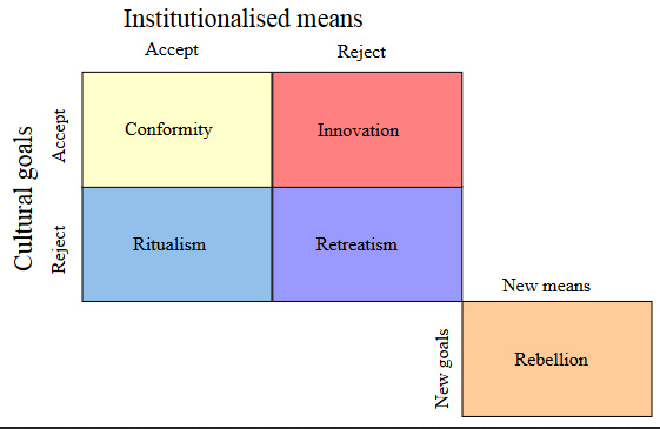
People may accept cultural goals and the institutional means, however they might reject one or both (indicated by a + or - in the table below). This creates the fourfold grid above: Conformity, Innovation, Ritualism and Retreatism. It is also possible that instead of rejecting both goals and means in a particular situation, people may actively create new goals and means: Rebellion. Merton explains (1938a:676, fn 12):
This fifth alternative [Rebellion] is on a plane clearly different from that of the others. It represents a transitional response which seeks to institutionalize new procedures oriented toward revamped cultural goals shared by the members of the society. It thus involves efforts to change the existing structure rather than to perform accommodative actions within this structure, and introduces additional problems with which we are not at the moment concerned.

Parsons attempts to integrate his own general theorizing with the “middle range” or “special case” of Merton’s. Where Merton considers deviance to be a response to “anomie,” Parsons considers deviance to be but one possible response to “strain.” Similar to anomie, strain results when there is a misalignment between expectations and behavior. That is, when someone else does something that I don’t expect. (Although deviance may in turn cause strain, they are two distinct concepts). Not all strain results in a deviant response, and Parsons outlines several possible alternative reactions to strain. Like Merton, if strain results in a deviance, the person is likely to respond with general ambivalence (leaning toward conformity or alienation), and they may respond passively or actively. Combining these dimensions results in a fourfold typology reminiscent of Merton’s.
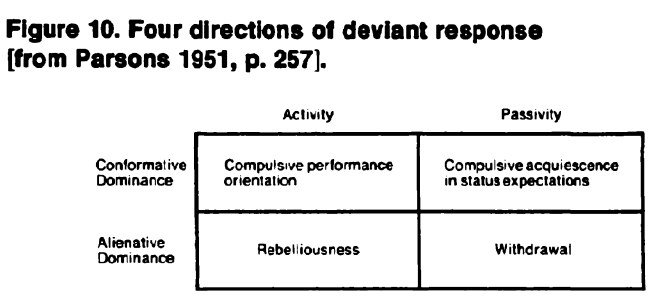
Parsons adds one more dimension to create the eightfold typology below. A person, responding deviantly, may direct their actions toward people (or social objects) or toward norms.
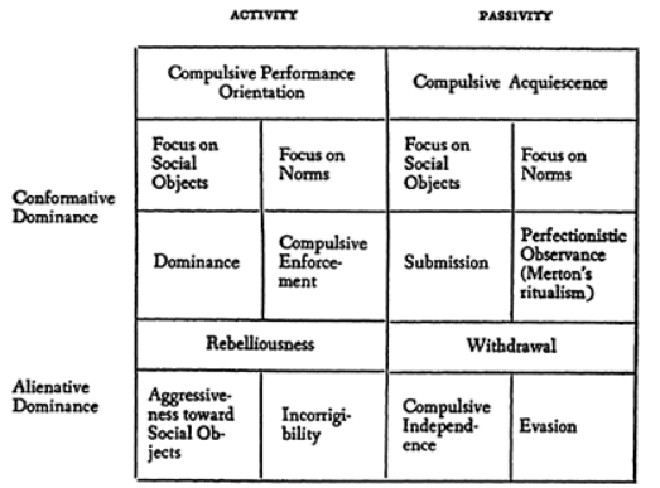
Extensions #
Harary (1966) proposed a ninefold typology. Haray argues that in addition to acceptance (+) and rejection (-) there is also indifference (0). When properly acknolwedged, this implies four other combinations which remain omitted in the original formulation.
The two sins of notation are: (1) use of the same symbol for two or more different ideas, and (2) use of two different symbols for the same idea. Both of these sins are committed in Merton’s typology. Briefly, the first sin occurs when the minus sign signifies utter indifference in the case of the goals of Ritualism, but rejection with substitution of new objectives in the case of the means of Innovation. The second sin is encountered when the minus sign for Innovation means and the + symbol for Rebellion goals and means are endowed with the same significance, viz., rejection with substitution.

Haray fills these in with: Beatnikism, Wishism, Antiwishism, and Developmentism.

But, wait! There’s more. Dubin (1959) first proposes a “revision” of Merton’s typology given what Merton has written about it:
This interpretation of Merton’s paradigm requires that for innovation the simple re- jection of institutionalized means be replaced by an active rejection (rejection and sub- stitution)…. This initial revision simply modifies the formal Merton typology so as to conform with the actual meaning he gives to innovation in his illustrated discussion of it.
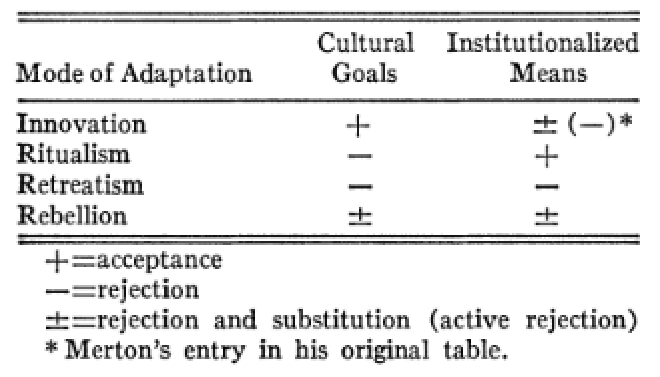
Next, Dubin proposes a twelve-fold typology of deviance by dividing adaptions into “behavioral” and “value” depending on whether cultural goals or institutionalized means are rejected/substituted.
The next logical step in modifying the Merton typology is afforded by the common distinction… between the actual behavior of the actor and the values guiding his selection of particular behaviors. This distinction introduces two additional modes of adaptation in the model: we can now subdivide innovation and ritualism into two categories.
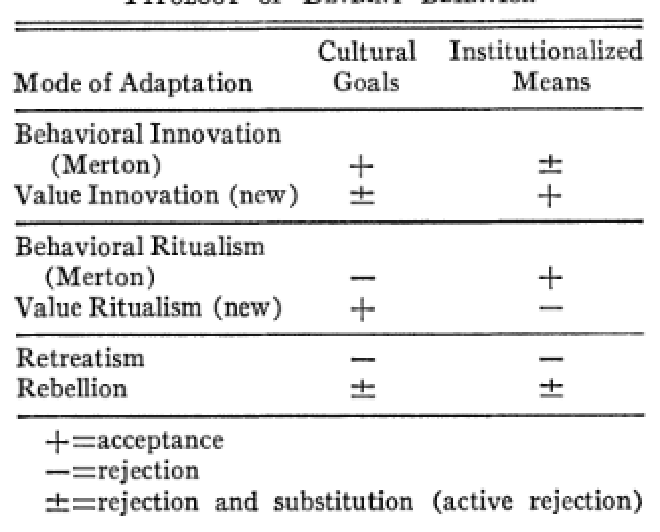
Finally, Dubin divides the “institutional” into the “institutionalized means” and the “institutionalized norms” to arrive at a forty-two-fold typology of deviance!
. Institutional norms set the limits between which the institutional means are prescribed – the limits of legitimate behaviors in a particular institution. Beyond the norms lie illegitimate behaviors. Institutional means, in contrast, are the specific behaviors, prescribed or potential, that lie within the limits established by institutional norms. Institutional means are actual behaviors of people, the things they do in carrying out functions in the institutional setting in which they are acting. This distinction is incorporated in the typology of modes of deviant adaptations in social action…
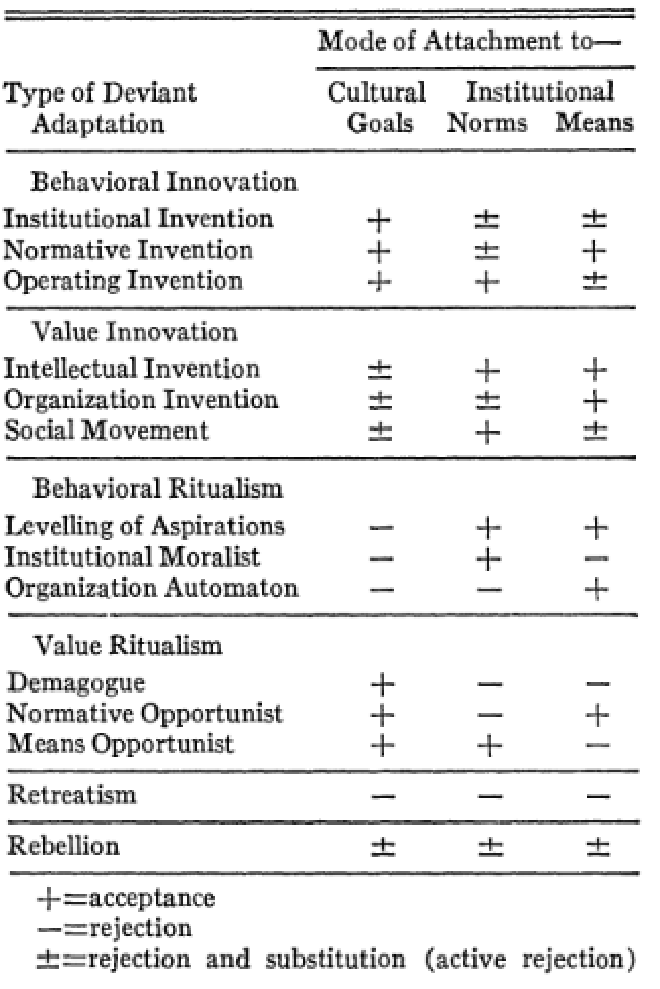
Epilogue #
I first wrote this post about a decade ago (Stoltz 2014), before going starting my doctorate program. It was also published under a title that I no longer use (The Brief Note) and a URL I no longer own (thebriefnote.com). I have updated this post very lightly and added a few more elaborations of the typology.
References #
Dubin, R. 1959. “Deviant Behavior and Social Structure: Continuities in Social Theory.” American Sociological Review 24(2):147–64.
Harary, F. 1966. “Merton Revisited: A New Classification for Deviant Behavior.” American Sociological Review 31(5):693–97.
Merton, R. 1938. “Social Structure and Anomie.” American Sociological Review 3(5):672–82.
Merton, R. 1968. Social Theory and Social Structure. Simon and Schuster.
Parsons, T. [1951] 2013. The Social System. Routledge.
Smelser, N., and R. Warner. 1976. Sociological Theory: Historical and Formal. General Learning Press.
Stoltz D. 2014. “Diagrams of Theory: Merton’s and Parson’s Typology of Deviance” The Brief Note, January 26. (http://thebriefnote.com/blog/2014/01/26/diagrams-of-theory-mertons-and-parsons-typology-of-deviance/).
Waring, E., D. Weisburd, and E. Chayet. 1995. “White-Collar Crime and Anomie.” in The Legacy of Anomie Theory pp. 207–25.